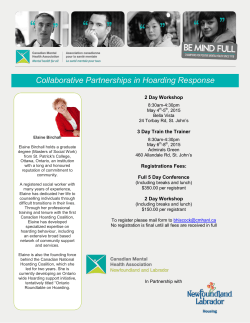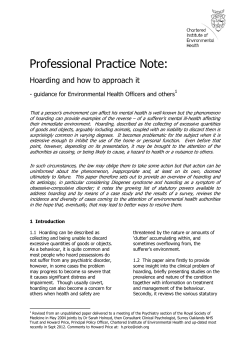
Victoria Hampton`s Hoarding and DD PPT
Hoarding and Developmental Disabilities: Coping and Prevention June 3, 2015 Mission To offer specialized programs and services that are accessible to older Manitobans that support and enhance their social, emotional, physical, intellectual and spiritual lives and promote active participation in all aspects of community life. 2 Vision To develop and deliver innovative programs and services that improve the quality of later life. 3 The Agency • A not-for-profit organization that provides programs and services to older adults 55+ • Established in 1957 in response to the need from older adults and their caregivers • Governed by a Board of Directors 4 3 Pillars of Innovative Programs & Services: • Safety & Security • Social Engagement • Counselling 5 Overview • This Full House • What is Hoarding? • Assessment • Best Practices • Resources • Questions 6 ‘This Full House’ • Voluntary program for older adults (55+) that addresses hoarding and squalor • Client participation is essential • Uses cognitive rehabilitation and exposure therapy with the goal of harm-reduction • Involves counseling, sorting/cleaning services, follow-up, and referral 7 Getting Help Referrals come from a variety of sources: • • • • Self-referrals Family/Other Supports Community/Government Agencies Housing Contact A & O and request to speak with Intake *In order for referral to be made, consent must be given 8 Funders 9 Problem behavior? Mental Illness? Symptom of something else? OCD? “Hoarding” Collecting? Excuse for being lazy? Only on TV? 10 Compulsive Hoarding • The acquisition of, and failure to discard a large number of possessions that appear to be of useless or of limited value; • Living spaces sufficiently cluttered so as to preclude activities for which the spaces were designed; and • Significant distress or impairment caused by the hoarding. (Frost & Hartl, 1996) 11 Hoarding Disorder Diagnostic criteria for DSM-5 (Obsessive-Compulsive & Related Disorders category): A. B. C. D. E. Persistent difficulty discarding or parting with personal possessions, even those of apparently useless or limited value, due to strong urges to save items, distress, and/or indecision associated with discarding. The symptoms result in the accumulation of a large number of possessions that fill up and clutter the active living areas of the home, workplace, or other personal surroundings (e.g., office, vehicle, yard) and prevent normal use of the space. If all living areas are uncluttered, it is only because of others’ efforts (e.g., family members, authorities) to keep these areas free of possessions. The symptoms cause clinically significant distress or impairment in social, occupational, or other important areas of functioning (including maintaining a safe environment for self and others). The hoarding symptoms are not due to a general medical condition (e.g. brain injury, cerebrovascular disease). The hoarding symptoms are not restricted to the symptoms of another mental disorder (e.g., hoarding due to obsessions in Obsessive-Compulsive Disorder, lack of motivation in Major Depressive Disorder, delusions in Schizophrenia or another Psychotic Disorder, cognitive deficits in Dementia, restricted interests in Autistic Disorder, food storing in Prader-Willi Syndrome). 12 Collecting vs. Hoarding Collecting: Hoarding: • • • • • Usually disorganized • Takes over areas of home • Cause of distress • Risk to health • Safety concerns Organization Mint condition Kept in specific areas Quality of life not compromised • Pride 13 14 15 Squalor 16 Squalor • The state of living in unsanitary conditions which may include human or animal feces, rotting food, and infestations of rodents/insects • May or not involve hoarding behaviors • Like hoarding, squalor can pose a myriad of health and safety concerns 17 Hoarding Profile Who? • Often begins in adolescence, severity increases with age • Might occur alongside other conditions (e.g. depression, anxiety) • Often single • Treatment sought in 50’s – women more than men • Range of education, income 18 What? • • • • • • • Clothing Written information/material Food Craft items Containers, bags Used wrappers, bottles, tissues _______________________ 19 Where? • • • • • • Own home Multiple properties Storage Vehicle Friends/parents Acreage 20 Why? • Other illnesses/diagnoses • Family History of Hoarding – Genetics, environment • Beliefs about Possessions – Sentimental value, utility, beauty • Cognition – Differences in brain function and thought processes • Avoidance 21 • • • • • Object has emotional significance Losing important information Wasting useful objects Object is beautiful or unique It “doesn’t feel right” to get rid of it 22 How? • • • • • • Shopping Online shopping Garage sales, free weekends Relatives, friends Trash, recycling bins Workshops, fairs 23 Assessing Risks • Physical Health & Safety – – – – – Falls, tripping over clutter Unable to use bed, eat at table, navigate stairs Food poisoning Infestations Services may not be available (e.g. plumbing, electrical, Home Care) 24 Assessing Risks • Emotional/Social – – – – – – – Shame, embarrassment Anxiety Depression Feel overwhelmed Family/marital discord Reluctant to have visitors Stress from family, landlords, etc. 25 Assessing Risks • Financial – – – – – – Cost of accumulating belongings Moving due to eviction Complying with City orders Fines Damage to home/property Losing bills/important documents 26 Assessing Risks • Home Safety - falls, fire hazards, rotting food, animals, infestations, structure, other parties • Personal Safety - coping, social support, self-care, distress, risk of homelessness, overall health 27 Best Practices • • • • Basic Strategies Curiosity over Criticism Reducing Acquiring Treatment – Harm Reduction – Cognitive Rehabilitation – Sorting/Discarding *Aim for client participation wherever possible – goal is sustainable change that involves client 28 Basic Strategies • Establish trust and respect • Don’t touch • Share concerns about safety • Ask questions • Respect each individual’s process • Allow the individual to • • • • • • take control Provide resources Respect decision(s) Encourage any progress Be patient Family – take a step back Pick your battles 29 Avoid: • • • • • • Judgmental language Touching / removing items Forced clean ups Arguing Overwhelming demands / unrealistic expectations Manipulation 30 Challenges • • • • • • • Lack of trust Past attempts Physical barriers Mental health concerns Dementia Lack of motivation Time/Deadlines 31 Curiosity over Criticism • Why are you keeping this item / Can you tell me about this item? • What might happen if this was lost or was thrown away? • How do you feel about your bedroom/home/space? • How were you feeling / what were you thinking about before buying this item? • How did you feel after buying it? *Match the language used by the individual 32 Reducing Acquiring • Determine the source • Redirect – replace with other pleasurable activities • Positive reinforcement – rules/rewards • Find a safer (or smaller) item to collect • Limit access (space, locks, funds) 33 Treatment Harm Reduction • Target most concerning areas without requiring hoarding behaviors to stop completely – Create safer living environment by working on one goal at a time (i.e. pathway to front door) – Reduce collecting by setting limit (i.e. 1 item/week, cannot exceed shoebox) 34 35 Treatment Cognitive Rehabilitation • Approach designed for older adults • Targets executive functioning skills (memory, attention, problem solving) – Calendar Use, To Do List, Goal Setting – Problem Solving Model – DBESTE 36 Treatment Sorting/Discarding • Strategies based on exposure therapy • Repeated exposure to decision-making about belongings (sorting/discarding) which, over time, leads to a decrease in distress • Client involvement required for long-term change 37 Treatment Sorting/Discarding • Tracking distress: emotion faces, numbers, etc. • Hierarchy – least to most distressing • Prepare – supplies etc. • One area at a time • Make a list ahead of time/visualization • Rule Lists • • • • • • • Rewards Limit time spent sorting Space/numerical limits Categorizing: looks like? Choose between items Social stories Multi-disciplinary approach 38 39 40 Resources • A & O – This Full House • OCD Centre Manitoba Other Helpful Services: • Employment & Income Assistance • City of Winnipeg (Bylaws & Community Services) • Contracted professional services – Professional Organizers – Cleaning Services – Hauling Services 41 Questions? 42 References Ayers, C., Twamley, E., Espejo, E., Saxena, S., and Wetherell, J. (2011). CREST: Cognitive Rehabilitation and Exposure/Sorting Therapy for Compulsive Hoarding. VA San Diego Healthcare System, University of California. Berry C. and Schell, R.M. (2006). Reducing Hoarding Behavior with Individualized Reinforcement and Item Return. Behavioral Interventions 21, 123-135. Gallo, K., Wilson, L., and Comer, J. (2012). Treating hoarding disorder in childhood: A case study. Journal of Obsessive-Compulsive and Related Disorders 2, 62-69. Tompkins, M. and Hartl, T. (2009). Digging Out. New Harbinger Productions, Oakland CA. Steketee, G. and Frost, R. O. (2000). Compulsive Hoarding and Acquiring: Therapist Guide. Oxford English Press. Storch, E., Rahman, E., Park, J., Reid, J., Murphy., and Lewin, A. (2011). Compulsive Hoarding in Children. Journal of Clinical Psychology Vol. 67 (5). Tolin, D., Frost, R., and Steketee, G. (2014). Buried in Treasures: Help for Compulsive Acquiring, Saving, and Hoarding. Oxford University Press. www.iocdf.com https://www.autismspeaks.org/blog/2015/02/06/autism-hoarding-adult-son-fearsparent%E2%80%99s-help-overflowing-room 43 A & O Services Safety & Security Social Engagement Counselling • Elder Abuse Prevention Services • Safe Suite Program • Older Victim Services • SafetyAid • This Full House • Senior Centre Without Walls • Connect Program • Entry Program for Older Adult Immigrants • Centres/Meals Programs • Information & Referral • Intake • Counselling • Housing • Legal Clinics 44 Thank you! Contact info: A & O: Support Services for Older Adults 200-280 Smith St. Winnipeg, MB R3C 1K2 Phone: 204-956-6440 Toll-free: 1-888-333-3121 Fax: 204-946-5667 e-mail: info@aosupportservices.ca 45
© Copyright 2025












